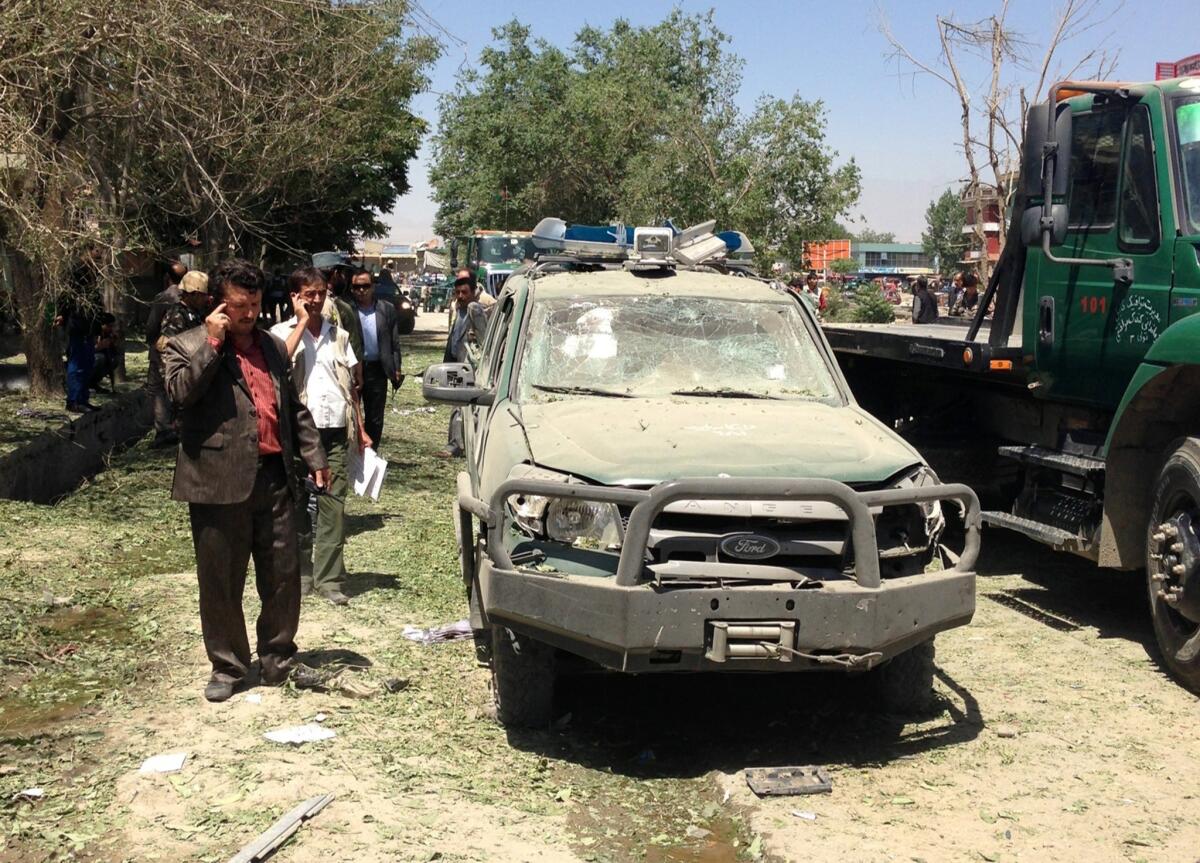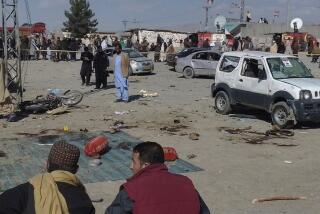Bombing mars final NATO transfer of Afghan security duties

KABUL, Afghanistan -- An hour before NATO transferred formal responsibility for the nationâs security to Afghan forces, a large bomb targeting a minority lawmaker exploded in western Kabul on Tuesday morning, killing three civilians and wounding more than a dozen others, police said.
The intended target, Mohammad Mohaqiq, a prominent lawmaker and former Cabinet member from the minority Hazara community, survived the attack but at least four bodyguards in his convoy were wounded, said Gen. Mohammad Daud Amin, Kabulâs deputy police chief.
No group claimed immediate responsibility but the blast, a roadside bomb detonated by remote control, was specifically designed to disrupt Tuesdayâs security transition, said Gen. Mohammad Zahir, head of Kabulâs crime and investigation unit.
The assault in the western Pul-e Surkh area of Kabul, near the headquarters of the Afghan Independent Human Rights Commission, was the fifth high-profile strike in six weeks on the heavily guarded capital. The Taliban said it would target foreign troops, U.N. officials and Afghans working with international forces at the start of its spring offensive, a time when warmer weather generally brings more intense fighting.
Tuesdayâs attack came minutes before a ceremony attended by Afghan President Hamid Karzai and NATO Secretary-General Anders Fogh Rasmussen marking the formal hand-off of security responsibility to the Afghan National Security Forces.
The transition is a major milestone in the 12-year-old war. In practice, however, about 100,000 international combat troops will continue to provide intelligence, training, air power and ground forces as needed for the foreseeable future.
The U.S.-led coalition insists that after years of training Afghan forces are strong enough to take the lead in fighting the Taliban.
Critics counter that the 350,000-strong Afghan national security forces suffer from inadequate training and morale and arenât ready, but are nevertheless being pushed into a commanding role by NATO members keen to withdraw their combat troops by late 2014 and end the high cost and body count of a protracted conflict.
At least 2,100 members of the U.S. military have died in Afghanistan, including over 1,740 killed in conflict situations, since the U.S.-led invasion in late 2001, according to the Associated Press.
Tuesdayâs ceremony at the Afghan National Security University in Kabulâs Qargha district, which featured several Afghan flags and an oversized photo of Karzai, saw the transfer of 95 remaining districts. This is the fifth and final stage of a two-year transition to build up the confidence and capability of Afghan forces. It started with areas, such as Bamiyan, deemed relatively safe.
Included in the transfer of security duties were 13 areas in Kandahar province -- the spiritual home of the Taliban -- and 12 areas each in Nangarhar, Khost and Paktika, all hotbeds of insurgent activity near Afghanistanâs border with Pakistan.
Mohaqiq, leader of the Peopleâs Islamic Unity Party of Afghanistan, is a member of the National Front representing members of the former Northern Alliance that battled the Taliban before the U.S. invaded in 2001.
Mohaqiq said in a telephone interview that he was on his way to parliament when the bomb exploded, wounding as many as 22 people including nine bodyguards. âI think the Afghan security forces are not in a position to provide security nationwide and need more training,â he said.
The Taliban, predominantly made up of ethnic Pashtuns, persecuted the Hazara minority during their five-year rule. The Taliban sought to impose a radical interpretation of Islamic law. The Hazara face ongoing attacks and discrimination.
After months of relative calm in Kabul, the Taliban has since early May shown its ability to strike with relative ease at the heart of the Karzai government just as the country prepares for 2014 presidential elections.
Among recent attacks on Kabul include a suicide car bomb last week that killed at least 15 civilians outside the Supreme Court, an attack at the airport a day earlier, and a strike on an international aid groupâs compound last month that led to a seven-hour gun battle.
[For the Record, 12:23 p.m. PDT June 18: An earlier version of this post said the Afghan national army is 350,000-strong. That number includes other Afghan security forces.]
ALSO:
Tens of thousands protest conditions in Brazil
Edward Snowden calls U.S. intelligence âaggressively criminalâ
Iranâs next president promises more openness on nuclear program
Special correspondent Baktash reported from Kabul and Magnier reported from New Delhi.
More to Read
Sign up for Essential California
The most important California stories and recommendations in your inbox every morning.
You may occasionally receive promotional content from the Los Angeles Times.










